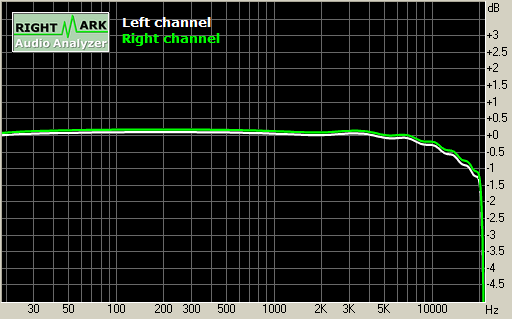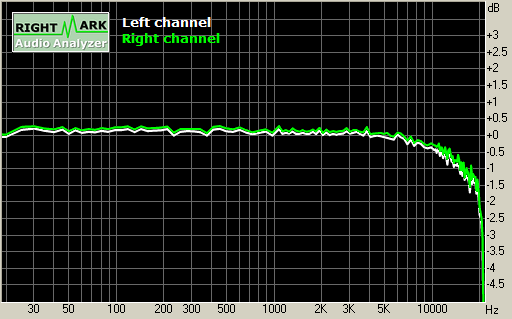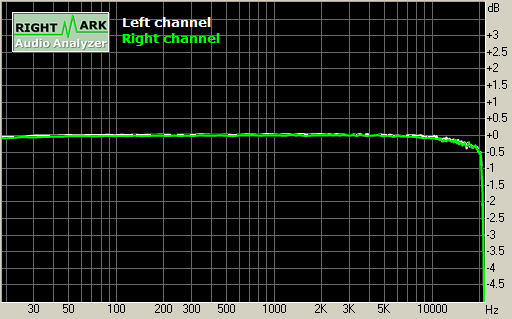Eagle_Driver
Headphoneus Supremus
- Joined
- Jun 22, 2001
- Posts
- 6,496
- Likes
- 61
Here is my RightMark report for the Sony D-EJ001 (with frequency response graphs):
With G-Protection Off:
Frequency response (from 40 Hz to 15 kHz), dB: +0.10, -0.78 Good
Noise level, dB (A): -83.9 Good
Dynamic range, dB (A): 84.2 Good
THD, %: 0.011 Good
IMD + Noise, %: 0.023 Good
Stereo crosstalk, dB: -83.6 Very good
IMD at 10 kHz, %: 0.048 Good
General performance: Good

With G-Protection On:
Frequency response (from 40 Hz to 15 kHz), dB: +0.20, -0.95 Average
Noise level, dB (A): -83.9 Good
Dynamic range, dB (A): 83.8 Good
THD, %: 0.026 Good
IMD + Noise, %: 1.619 Poor
Stereo crosstalk, dB: -85.3 Excellent
IMD at 10 kHz, %: 7.709 Very poor
General performance: Good

For comparison, here is my RightMark report for the Sony D-NE300:
With G-Protection set at 1:
Frequency response (from 40 Hz to 15 kHz), dB: +0.03, -0.20 Very good
Noise level, dB (A): -87.6 Good
Dynamic range, dB (A): 87.1 Good
THD, %: 0.035 Good
IMD + Noise, %: 0.045 Good
Stereo crosstalk, dB: -76.4 Very good
IMD at 10 kHz, %: 0.038 Good
General performance: Good

With G-Protection set at 2:
Frequency response (from 40 Hz to 15 kHz), dB: +0.04, -0.21 Very good
Noise level, dB (A): -87.4 Good
Dynamic range, dB (A): 86.7 Good
THD, %: 0.034 Good
IMD + Noise, %: 0.468 Poor
Stereo crosstalk, dB: -76.2 Very good
IMD at 10 kHz, %: 1.928 Poor
General performance: Good

Now for the frequency response graph comparison between the two players (G-Protection set to their minimum settings):

In short, the D-EJ001 does not perform as well as the D-NE300, despite its more powerful headphone out. There is some compression in the higher frequencies with this PCDP, even without antiskip. (The iRiver SlimX PCDPs, despite their FR flaws, roll off smoothly, unlike the D-EJ001.) But the G-Protection on the D-EJ001 actually compresses the audio significantly, unlike the negligible compression that the G-PRO 2 setting imposes on the D-NE300 - in fact, the D-EJ001's anti-skip compresses the audio even more than the compressed anti-skip mode in the "good" Panasonic PCDPs.
So the D-EJ001 sounds mediocre. But hey, it costs only $30! You get what you pay for, in this case.
Hope you've enjoyed this comparison mini-review.
Randall
With G-Protection Off:
Frequency response (from 40 Hz to 15 kHz), dB: +0.10, -0.78 Good
Noise level, dB (A): -83.9 Good
Dynamic range, dB (A): 84.2 Good
THD, %: 0.011 Good
IMD + Noise, %: 0.023 Good
Stereo crosstalk, dB: -83.6 Very good
IMD at 10 kHz, %: 0.048 Good
General performance: Good

With G-Protection On:
Frequency response (from 40 Hz to 15 kHz), dB: +0.20, -0.95 Average
Noise level, dB (A): -83.9 Good
Dynamic range, dB (A): 83.8 Good
THD, %: 0.026 Good
IMD + Noise, %: 1.619 Poor
Stereo crosstalk, dB: -85.3 Excellent
IMD at 10 kHz, %: 7.709 Very poor
General performance: Good

For comparison, here is my RightMark report for the Sony D-NE300:
With G-Protection set at 1:
Frequency response (from 40 Hz to 15 kHz), dB: +0.03, -0.20 Very good
Noise level, dB (A): -87.6 Good
Dynamic range, dB (A): 87.1 Good
THD, %: 0.035 Good
IMD + Noise, %: 0.045 Good
Stereo crosstalk, dB: -76.4 Very good
IMD at 10 kHz, %: 0.038 Good
General performance: Good

With G-Protection set at 2:
Frequency response (from 40 Hz to 15 kHz), dB: +0.04, -0.21 Very good
Noise level, dB (A): -87.4 Good
Dynamic range, dB (A): 86.7 Good
THD, %: 0.034 Good
IMD + Noise, %: 0.468 Poor
Stereo crosstalk, dB: -76.2 Very good
IMD at 10 kHz, %: 1.928 Poor
General performance: Good

Now for the frequency response graph comparison between the two players (G-Protection set to their minimum settings):

In short, the D-EJ001 does not perform as well as the D-NE300, despite its more powerful headphone out. There is some compression in the higher frequencies with this PCDP, even without antiskip. (The iRiver SlimX PCDPs, despite their FR flaws, roll off smoothly, unlike the D-EJ001.) But the G-Protection on the D-EJ001 actually compresses the audio significantly, unlike the negligible compression that the G-PRO 2 setting imposes on the D-NE300 - in fact, the D-EJ001's anti-skip compresses the audio even more than the compressed anti-skip mode in the "good" Panasonic PCDPs.
So the D-EJ001 sounds mediocre. But hey, it costs only $30! You get what you pay for, in this case.
Hope you've enjoyed this comparison mini-review.
Randall


